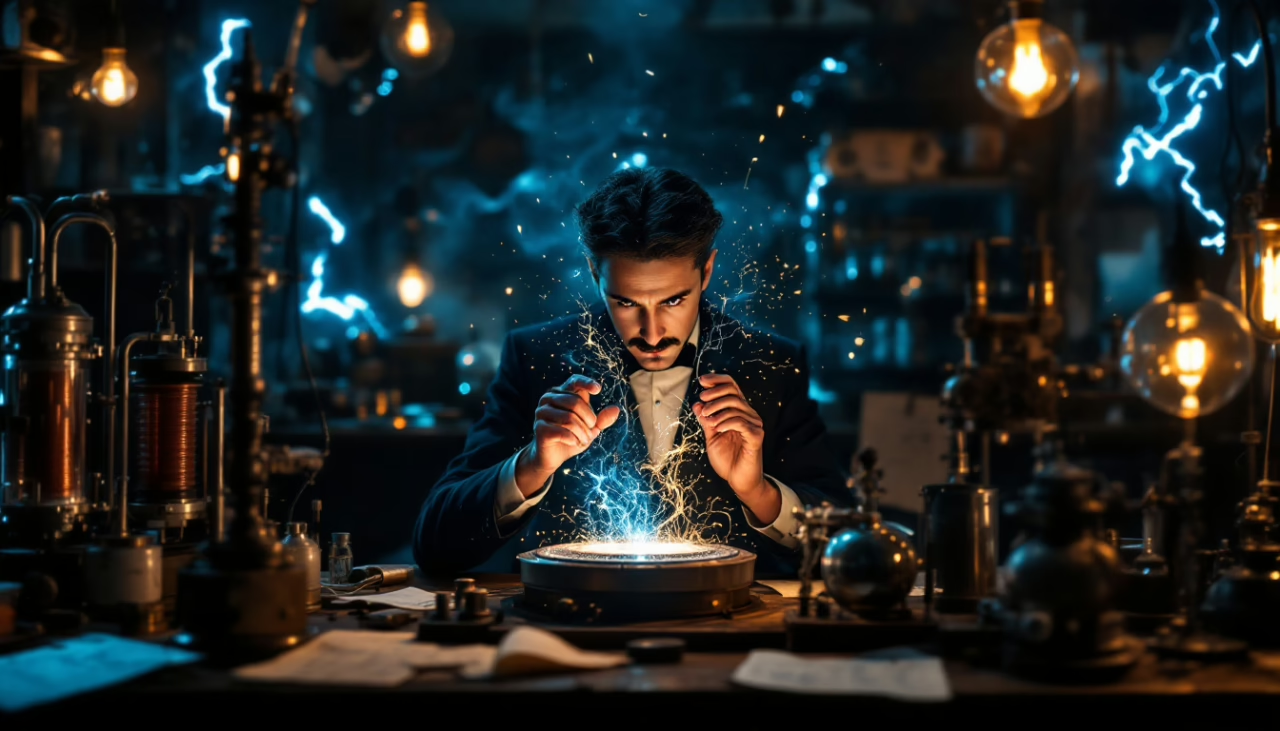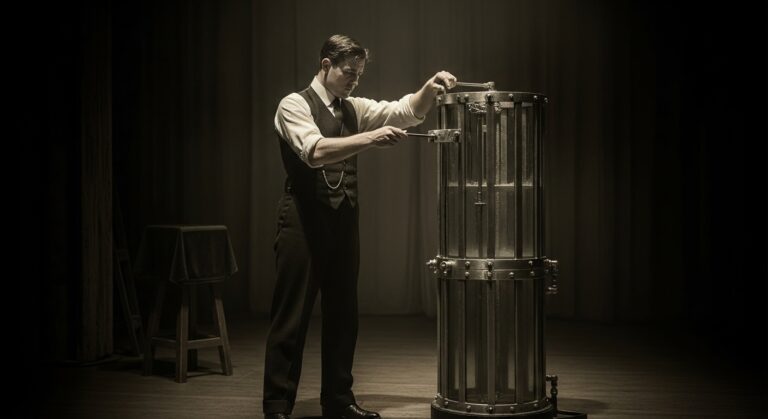The Enigma of Nikola Tesla: Genius, Visionary, or Mad Scientist?

Nikola Tesla inhabits a liminal space in scientific history.
His brilliant contributions to electrical engineering—particularly alternating current systems—revolutionized modern life, yet his later proclamations about death rays and interplanetary communication relegated him to the margins of serious discourse.
Contemporary accounts describe a man of precise habits and extraordinary vision, simultaneously practical and wildly speculative.
Tesla’s notebooks reveal methodical experimentation alongside fantastical theories, challenging our neat categorizations of scientific legitimacy. The question remains whether society misjudged a genius who simply saw beyond his era’s limitations.
Summary & Key Takeaways
Hide- Tesla embodied all three aspects: a genius in AC electricity, a visionary in wireless energy, and eccentric in personal habits.
- His documented innovations in electromagnetic fields and AC systems confirm his scientific genius beyond dispute.
- Tesla's wireless energy vision transcended his era, anticipating future technologies 100 years before their time.
- His unusual behaviors, including obsessive cleanliness and numerical rituals, fueled the "mad scientist" perception.
- Cultural reevaluation has shifted Tesla's image from forgotten eccentric to celebrated genius whose ideas were ahead of his time.
Early Life Nikola Tesla: His Formative Years

Tesla’s childhood in the Austrian Empire, marked by his mother’s mechanical inventions and his father’s extensive theological library, cultivated an environment where creativity and intellectual pursuit flourished simultaneously.
During his formative years, Tesla demonstrated extraordinary mental capabilities, including photographic memory and powerful visualization skills that would later become instrumental in his unconventional approach to invention.
Despite academic excellence at the Austrian Polytechnic, his early professional trajectory was fraught with obstacles—abandoning his studies before completion and experiencing debilitating illness—foreshadowing the pattern of brilliance coupled with adversity that would characterize his later life.
Childhood Influences and Early Curiosity
Tesla’s childhood in the rural village of Smiljan, then part of the Austrian Empire, established the foundation for his extraordinary scientific journey, where the region’s thunderstorms likely sparked his lifelong fascination with electricity.
His mother, Đuka Tesla, an inventor of household appliances despite her lack of formal education, cultivated his mechanical aptitude, while his father, Milutin, an Orthodox priest with an extensive library, instilled in him intellectual discipline and curiosity.
The interplay between these parental influences, combined with the adversity of losing his brother Daniel in a riding accident when Tesla was seven, forged the resilient, imaginative mindset that would later revolutionize electrical engineering.
Growing up in Smiljan: Inspiration and challenges
Born in the small Croatian village of Smiljan in 1856, Nikola Tesla emerged from humble beginnings that would profoundly shape his innovative mindset and extraordinary vision.
Amid rustic village life, his childhood dreams flourished despite challenging family dynamics.
Tesla’s early inventions—primitive waterwheels and mechanical insects—reflected both natural curiosity and diverse cultural influences from the Austro-Hungarian borderlands where Eastern and Western traditions intermingled.
Key figures shaping young Tesla’s interests
Within the tapestry of influences that molded young Nikola’s intellectual development, several key figures stand prominently as architects of his scientific imagination.
His father, Milutin, an Orthodox priest with intellectual curiosity, provided early educational influences, while his mother Đuka’s mechanical aptitude shaped his inventive spirit.
Professor Pöschl emerged as one of Tesla’s influential mentors, nurturing his talents against a rich cultural background of Serbian tradition.
Academic Pursuits and Early Struggles
Tesla’s academic journey began at the Polytechnic Institute in Graz, Austria, where his exceptional aptitude for mathematics and physics first garnered attention from professors who noted his capacity to perform integral calculus in his head.
At Graz, he encountered the Gramme dynamo, an alternating current electrical generator that sparked his lifelong obsession with electricity and magnetism, despite his father’s initial insistence that he pursue the clergy.
After departing Graz without a degree, Tesla briefly attended Charles-Ferdinand University in Prague, where, despite financial hardships and linguistic challenges, he continued to refine the revolutionary electrical concepts that would later transform modern civilization.
Studies at Graz and Prague
Several promising academic institutions shaped Tesla’s intellectual development during his formative years, with the Graz University of Technology marking his initial foray into formal higher education in 1875.
Despite excelling in his curriculum at Graz, Tesla faced academic challenges—financial constraints forced his departure before completing his degree.
His brief studies at Prague, though abbreviated, profoundly influenced his theoretical framework, particularly regarding electromagnetic principles.
The beginnings of Tesla’s fascination with electricity
A profound interest in electrical phenomena emerged during Nikola Tesla’s childhood, sparked by mysterious static discharges he observed while stroking his cat Macak.
This spark of inspiration fueled relentless scientific curiosity, leading to primitive electricity experiments and childhood inventions crafted from household materials.
Early mentors, particularly his physics teacher, recognized Tesla’s extraordinary aptitude, nurturing the brilliant mind that would later revolutionize electrical engineering.
Tesla’s Groundbreaking Inventions
Tesla’s pivotal work on Alternating Current (AC) fundamentally transformed electrical distribution systems, establishing a framework that outperformed Edison’s Direct Current and continues to power modern civilization.
His eponymous Tesla Coil, which generated high-voltage, low-current electricity, represented his ambitious vision of wireless energy transmission across global distances.
These revolutionary inventions, documented in his meticulous laboratory notes from 1891-1900, illustrated Tesla’s prescient understanding of electromagnetic principles that transcended the scientific orthodoxy of his era.
Alternating Current (AC) Revolution
Tesla’s alternating current system revolutionized the late 19th-century electrical landscape, enabling efficient transmission of electricity over vast distances through his ingenious polyphase innovations.
The ensuing “War of Currents” pitted Tesla and Westinghouse against Edison and his direct current system, a technological rivalry marked by Edison’s notorious public electrocutions of animals to demonstrate AC’s purported dangers.
Despite such underhanded tactics, Tesla’s AC ultimately prevailed as the superior technology, establishing the foundation for modern electrical infrastructure and cementing his legacy as one of history’s most transformative inventors.
Development and impact of Tesla’s AC system
While Edison clung to his direct current (DC) system with characteristic tenacity, the revolutionary alternating current (AC) technology pioneered by Nikola Tesla fundamentally transformed electrical distribution at the dawn of the modern era.
Tesla’s patents established unprecedented electrical efficiency, overcoming formidable engineering challenges that had previously limited transmission distances.
This breakthrough catalyzed global electrification, liberating humanity from geographical constraints and illuminating a path toward unprecedented technological freedom.
The famous “War of Currents” with Edison
The “War of Currents” erupted in late 19th century America as a technological and commercial battle that transcended mere business competition, evolving into one of history’s most consequential scientific rivalries.
Edison’s tactics included electrocuting animals publicly to demonstrate AC’s dangers—a calculated media portrayal that temporarily swayed public perception despite Tesla’s superior technology.
Financial struggles compounded Tesla’s challenges while the AC vs. DC debate ultimately determined electricity’s future.
Tesla Coil and Wireless Energy
The Tesla Coil, invented in 1891, represented one of Tesla’s most visually dramatic and scientifically significant creations—a resonant transformer circuit capable of producing high-voltage, low-current, high-frequency alternating current electricity.
Tesla envisioned this technology as merely the first step toward his more ambitious dream: a worldwide wireless energy transmission system that would provide free electricity to all humanity.
His experimental station at Wardenclyffe Tower, though ultimately abandoned due to financial limitations, embodied this revolutionary concept that, had it succeeded, might have fundamentally altered humanity’s relationship with energy resources and electrical power distribution.
Concept and significance of the Tesla Coil
Lightning captured in glass, Tesla’s resonant transformer coil stands as perhaps his most visually arresting invention, embodying both scientific precision and theatrical spectacle.
Through principles of electrical resonance, the device generated astonishing high voltage phenomena while demonstrating practical applications for wireless energy transmission.
Tesla’s public demonstrations captivated audiences, proving that scientific advancement could simultaneously illuminate both laboratories and the imagination.
Ambitious dreams of worldwide wireless power transmission
While Tesla’s resonant coil demonstrated localized energy transformation, his vision expanded far beyond laboratory walls to encompass nothing less than the entire globe.
He envisioned a revolutionary wireless technology that would liberate humanity from the constraints of the electrical grid, establishing global energy networks through innovative solutions.
This ambitious framework for a sustainable future remains both prophetic and enigmatic—a hallmark of Tesla’s unprecedented foresight regarding our civilization’s interconnected destiny.
Visionary or Mad Scientist?
Tesla’s unconventional theories about wireless energy transmission and communication with other planets marked him as either profoundly ahead of his time or, as critics suggested, untethered from scientific reality.
His personal eccentricities—including a reported obsession with the number three, profound germophobia, and claims of receiving extraterrestrial signals—further complicated public perception of his genius.
These enigmatic qualities, coupled with his solitary final years in the New Yorker Hotel, have transformed Tesla into a figure who inhabits the nebulous boundary between visionary scientist and mythologized eccentric, challenging historical attempts to categorize his legacy within conventional frameworks.
Tesla’s Unconventional Ideas
Tesla’s unconventional ideas extended far beyond his practical inventions, traversing into territories that blurred the line between visionary insight and seeming madness.
His concepts for wireless power transmission and global communication networks—dismissed as fantastical in his time—anticipated technological developments that would emerge decades later.
Perhaps most controversial were his claims regarding mechanical oscillators capable of generating artificial earthquakes and his theories about communicating with extraterrestrial civilizations, notions that simultaneously revealed the boundless nature of his imagination and fueled skepticism about his scientific credibility.
Exploring Tesla’s fascination with wireless communication
How did a man often dismissed as a dreamer accurately envision the wireless world we inhabit today?
Tesla’s pioneering theories on frequency modulation and global connectivity transcended contemporary understanding.
His vision of wireless energy transmission, though ridiculed by peers, demonstrated remarkable technological foresight.
Tesla conceptualized an interconnected planet long before digital networks emerged, envisioning communication theories that would ultimately liberate humanity from physical tethers.
Earthquake machines and other unusual concepts
While many historians celebrate Tesla’s contributions to electrical engineering and wireless technology, his more controversial inventions reveal the thin line between revolutionary thinking and scientific fantasy.
Tesla’s most unconventional theories included:
- The “earthquake machine” utilizing resonance frequency
- Devices capturing ambient psychic energy
- Weapons utilizing sound vibrations
- Communication systems detecting cosmic radiations
These concepts, though dismissed by contemporaries, exemplify Tesla’s unfettered imagination.
Personal Quirks and Mysteries
Tesla’s personal life was marked by pronounced eccentricities, including his rigid adherence to a daily routine that involved polishing dinner silverware with exactly eighteen napkins and his fear of touching hair, pearls, or objects with rounded edges.
His devotion to the number three manifested in peculiar ways—such as walking around buildings three times before entering—yet these behaviors coexisted with reports of his extraordinary mental capacity, which allegedly allowed him to visualize complex machinery with perfect precision before committing a single blueprint to paper.
These idiosyncrasies have fueled considerable debate about whether Tesla’s unconventional mental framework represented the necessary cognitive architecture of genius or symptomatic manifestations of psychological conditions that both enhanced and hindered his scientific pursuits.
Tesla’s eccentric routines and obsessions
Eccentricity shadowed Nikola Tesla’s brilliance like an ever-present specter, manifesting in ritualistic behaviors and phobias that both fueled and constrained his genius.
Tesla’s eccentric habits included:
- Rigorous cleanliness protocols requiring 18 napkins to sanitize dining utensils
- Pathological fear of germs, especially from human hair
- Profound attachment to pigeons, particularly one white bird he claimed to love
- Strict nighttime routines involving toe exercises and lightning calculations
His rumored extraordinary mental abilities
Imagination of extraordinary scale defined Tesla’s mental landscape, setting him apart from even the most brilliant scientific minds of his era.
His rumored photographic memory allowed perfect recall of complex schematics, while his visionary insights manifested through intuitive problem solving that bordered on prescience.
Tesla claimed his mental acuity permitted visualization of inventions functioning in three dimensions—a creative genius whose cognitive processes remain, paradoxically, both documented and mysterious.
Nikola Tesla: The Forgotten Genius
Tesla’s legendary rivalry with Thomas Edison, characterized by competing electrical system designs and public relations battles, overshadowed his numerous groundbreaking contributions to science and technology.
Historical records suggest that many of Tesla’s innovations—including wireless power transmission and advanced radio technologies—disappeared into obscurity or corporate archives following his financial troubles and loss of laboratory facilities.
This systematic erasure of Tesla from the scientific narrative raises profound questions about how intellectual property, corporate influence, and personal eccentricity shape the recognition of genius in historical accounts, particularly when innovations challenge established economic interests.
Tesla vs. Edison: A Historical Rivalry
While Tesla pioneered alternating current and pursued scientific advancement for humanity’s benefit, Edison, leveraging superior business instincts, commercialized direct current and aggressively marketed his inventions.
Their confrontation, known as the “War of Currents,” exemplifies how Edison’s entrepreneurial prowess guaranteed his lasting fame, while Tesla’s revolutionary contributions remained overshadowed despite their profound impact on modern civilization.
This asymmetry in recognition persisted throughout history, with Edison celebrated as America’s archetypal inventor while Tesla, despite his visionary achievements, faded into relative obscurity until recent scholarly reappraisal.
Differences in approach and business acumen
Vision, rather than technical capability alone, separated Edison and Tesla as they navigated the competitive landscape of late 19th-century innovation.
Their divergent business strategies and entrepreneurial vision manifested in four distinct approaches:
- Edison’s pragmatic marketing techniques vs. Tesla’s idealistic pursuits
- Edison’s competitive mindset focused on commercialization
- Tesla’s preference for theoretical breakthroughs over profit
- Financial struggles that plagued Tesla while Edison amassed wealth
Edison’s fame vs. Tesla’s relative obscurity
These divergent business approaches ultimately shaped how history would remember each man.
Edison’s public persona flourished through calculated media portrayal, while Tesla’s marketing struggles relegated him to historical shadows.
The innovation recognition disparity persisted for generations, though public perception shifts have gradually illuminated Tesla’s contributions.
Edison mastered self-promotion; Tesla, despite his revolutionary vision, failed to translate scientific brilliance into lasting cultural recognition.
Lost Innovations and Suppressed Patents
Following Tesla’s death in 1943, the Office of Alien Property seized numerous documents and inventions from his hotel room, sparking enduring questions about potentially revolutionary technologies that never reached public knowledge.
Historians and conspiracy theorists alike have speculated about these missing papers, which allegedly contained designs for wireless power transmission, advanced weaponry, and alternative energy systems that powerful industrial interests may have deliberately suppressed.
While substantive evidence for systematic suppression remains elusive, the curious gaps in Tesla’s documented work—particularly his later research on directed-energy weapons and scalar waves—continue to fuel scholarly debate regarding how different our technological landscape might have been had all his innovations reached fruition.
Controversies around Tesla’s missing documents
When government agents seized Tesla’s papers immediately following his death in January 1943, they inadvertently sparked one of science history’s most enduring controversies.
The missing archives have generated persistent questions about:
- Classified documents allegedly containing weapons designs
- Government secrecy surrounding the initial confiscation process
- Conspiracy theories regarding suppressed free energy technologies
- Historical retrieval efforts thwarted by bureaucratic obstacles
Speculations regarding suppressed inventions
Why do some of Tesla’s most revolutionary concepts remain shrouded in mystery, fueling decades of speculation about deliberately suppressed technologies?
Historians have documented numerous innovative designs allegedly confiscated by government agencies, while contemporary researchers point to hidden patents that threatened established corporate interests.
Tesla’s death intensified this narrative, as government secrecy surrounding his papers sparked enduring theories about technologies deemed too disruptive for public release.
Tesla’s Legacy Today
The twenty-first century has witnessed a remarkable renaissance in Tesla’s scientific reputation, with his prescient work on wireless technology and renewable energy finding newfound validation among contemporary researchers and engineers.
Museums, memorials, and academic institutions worldwide now honor his contributions, transforming the once-neglected inventor into a cultural icon whose name adorns everything from luxury electric vehicles to units of magnetic measurement.
This preservation of Tesla’s legacy serves not merely as historical rectification but as inspiration for modern innovators who recognize in his visionary approach the blueprint for sustainable technological advancement.
Revival of Interest in Tesla’s Work
In the decades following his death, Tesla’s contributions to modern technology, once overshadowed by contemporaries like Edison, have undergone significant reevaluation by scientists and historians alike.
His pioneering work in wireless transmission, alternating current, and remote control systems constitutes the foundation for numerous twenty-first century innovations, including wireless charging, drone technology, and radio communication frameworks.
Tesla’s enigmatic persona—characterized by his brilliant eccentricity and visionary forecasts—has simultaneously permeated popular culture, emerging in films, literature, and even as the namesake for Elon Musk’s revolutionary electric vehicle company, a reflection of the inventor’s enduring symbolic power as both scientific prophet and cultural icon.
Modern technologies influenced by Tesla’s research
Perhaps no inventor’s concepts have shifted so dramatically from historical obscurity to technological ubiquity as Nikola Tesla’s foundational work.
His influence permeates our Tech Revolution through:
- Wireless Technology powering global communications
- Modern Innovations in robotics and automated systems
- Sustainable Energy Solutions harvesting electromagnetic potential
- Remote control systems underpinning contemporary digital interfaces
Tesla’s prescient visions transcend mere invention, embodying humanity’s quest for technological liberation.
Tesla’s resurgence in popular culture
Why, after decades of relative obscurity, has Nikola Tesla emerged as a cultural icon whose name now graces luxury vehicles, rock bands, and Hollywood blockbusters?
Tesla’s Cultural Renaissance stems from our collective yearning for maverick thinkers who challenged establishment science.
Pop Culture Portrayals in Film and Artistic Interpretations frequently romanticize his eccentricities, while Modern Tesla Merchandise commodifies his revolutionary spirit for contemporary consumption.
Preserving the Memory of Nikola Tesla
Nikola Tesla’s intellectual legacy persists through a constellation of museums, memorials, and commemorations that span continents, from the Tesla Museum in Belgrade to the monument at Niagara Falls where his alternating current system first illuminated cities.
Artifacts of his inventions, personal correspondence, and laboratory notes are meticulously preserved in these institutions, offering researchers and enthusiasts alike a tangible connection to his revolutionary thinking.
Perhaps most notably, Tesla’s unorthodox approaches to electricity, wireless transmission, and energy continue to inspire contemporary inventors who, standing on the shoulders of this misunderstood giant, pursue innovations that might yet vindicate his most controversial theories.
Museums, memorials, and commemorations worldwide
The preservation of Tesla’s scientific legacy takes physical form through a global constellation of museums, memorials, and commemorative sites that honor his revolutionary contributions to electrical engineering and physics.
Tesla tributes worldwide include:
- Belgrade’s Tesla Museum housing 160,000+ original documents
- Niagara Falls monuments commemorating his hydroelectric achievements
- Colorado Springs laboratory replica documenting his wireless electricity experiments
- Wardenclyffe Tower restoration project preserving his wireless transmission vision
Continued inspiration for future inventors
How does a visionary’s intellectual blueprint continue to catalyze innovation decades after his death?
Tesla’s technological legacy reverberates through modern invention, with his radical concepts providing creative inspiration for future inventors pursuing wireless energy transmission and sustainable power solutions.
His visionary leadership, particularly in alternating current systems, demonstrates an innovation impact that transcends time—challenging contemporary engineers to reimagine what remains possible.
Wrapping Up
Tesla’s legacy, like electricity arcing between poles, bridges contradictions—illuminating both scientific achievement and human complexity.
History has transformed him from maligned outsider to revered prophet, his vindication arriving posthumously as renewable energy systems now reflect his once-dismissed visions.
Perhaps Tesla’s greatest invention was himself: a figure whose brilliance, like alternating current, continues to oscillate between the tangible and theoretical, perpetually generating intellectual power across generations.





